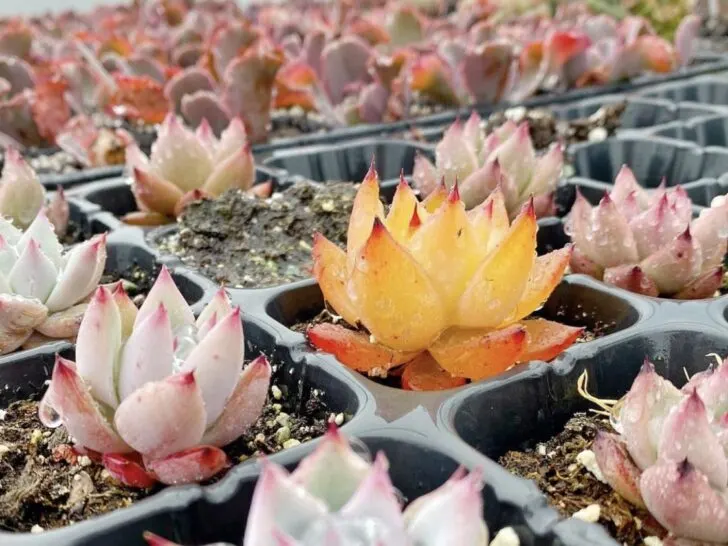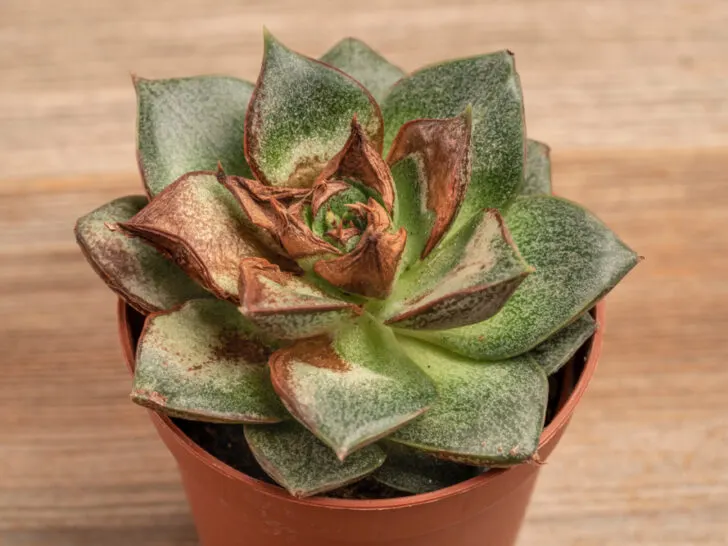
Succulent leaves falling off can be alarming for novice gardeners. You may associate the event with care and growth problems. However, succulents lose their leaves for a variety of reasons, ranging from a natural growth process to a reaction to over-fertilization.
If your succulent leaves fall off, assess your plant to determine the cause. If the growth shows no further signs of distress, you don’t need to do anything. However, if your succulent displays other damage indicators, you just need to tweak its environment a little.
In this article, we’ll look at the common reasons succulents lose leaves, and I’ll tell you when to worry and how to fix the problem.
7 Reasons Why Succulent Leaves Fall Off
Succulent leaves fall off because they’re unnecessary or for various environmental reasons. A little observation readily determines what’s causing your plant to shed.
Succulents lose leaves for seven primary reasons:
- The leaves are no longer needed
- Excessive watering
- Under-watering
- Too little light
- Over-fertilization
- Excessive heat
- Excessive cold
If caught on time, each of these causes can be mitigated, allowing your succulent a speedy recovery.
1. The Leaves Aren’t Necessary Anymore

Lower leaves often fall off as plants grow. Higher leaves fulfill the purpose the lower foliage used to serve, causing the needless greenery to brown and fall off.
Watch out for the frequency of the shedding. The occasional loss of bottom leaves is a natural shedding of chaff and nothing to be concerned about.
Naturally, leaves dry up and turn brown and crispy before falling. If the rest of the plant looks healthy, this shedding is a natural process for all succulents.
No further action is needed. The browning and drying of the leaves is only an aesthetic problem, so you can either let nature take its course or trim the dead foliage.
2. Excessive Watering

Too much water is the number one killer of succulents. It causes the plant’s cells to expand dangerously, leading to damage and possibly death.
Succulents are the camels of the plant world. They originated in low moisture locations and, as a result, thrive on very little water. Plant owners need to suppress a natural urge to moisten their succulents daily.
Indicators of over-watering include leaves that are:
- Yellow
- Soft
- Translucent
Over-watering also leads to root rot, so monitor your succulent’s root system. Succulents hold their own water supply and don’t need excessive moisture.
The plants do need water, but excessive fluids swell their leaves and weigh them down. This extra weight causes the foliage to fall off the succulents.
Treating Overwatered Succulents
You can salvage an overwatered succulent if you catch the problem in time. Proceed by removing any swollen leaves affected by the over-watering.
Check the stem. If the greenery manifests signs of rotting, cut them out and remove the remaining healthy succulent to a dry area for a week.
Resist the urge to water the succulent during this period. Once the week is up, re-pot the remaining healthy succulent. Stick to a proper water schedule and ensure your pot has appropriate drainage.
Proper Succulent Watering
Avoid the damage caused by excessive moisture by watering your succulents correctly. Wait until the soil is dry to the touch and the leaves show slight signs of wrinkling. Water the succulent thoroughly about once every one to two weeks.
Ensure your pot has drainage holes, so no excess water remains in the pot and drowns the plant’s roots. Use a good, grainy soil mixture, which allows for the best moisture drainage.
3. Not Enough Water

Succulents are drought-tolerant plants, making them popular among busy plant owners. They don’t require frequent watering and can tolerate a bit of neglect.
While you don’t want to over-water the plants, underwatering them for extended periods can be just as hazardous.
Signs of Underwatering
If your succulent’s foliage looks shriveled and sunken, you’ve probably been underwatering your plant. It’s very easy to tell if you’ve underwatered your plants. Look for soft, wrinkled leaves.
While these are a symptom of excessive watering as well, too much water causes a color change. Overwatered succulent leaves turn yellow, pale green, or translucent. On the other hand, underwatering doesn’t cause these changes.
Underwatered succulent foliage falls off easily. Even a light touch causes them to drop.
Treating Underwatered Succulents
If your plant isn’t too far gone, slightly increasing its water can save the succulent. The key word is ‘slightly’. Be cautious because succulents can easily be overwatered, and over-correcting is as damaging as underwatering.
You can soak the pot in a tub of distilled water until the soil is saturated. This usually takes 15-30 minutes. You can then let the pot sit on a drip tray for another 15 minutes to drain excess water.
Alternatively, you can water the soil deeply while avoiding pouring water on the foliage. Let the excess moisture drain out of the pot’s holes.
Watering your succulents thoroughly at least once a week during the warmer months will help them recover. You’ll also notice fewer leaves falling off.
4. Not Enough Light

Succulents love bright sunlight, although some may prefer indirect light. When they don’t get enough sunshine, the plants stretch out as they reach for warmth and light.
As the stems and branches stretch out to find a light source, the leaves become sparse and some may even fall off.
Look for these symptoms of insufficient light:
- Scraggly structure
- New leaves come in smaller than existing foliage.
If your succulent appears long and spindly, it is likely etiolated. Etiolation is the process where plants reach for sunlight, indicated by long and yellow limbs.
Etiolation and smaller leaves are indicators of insufficient light and indicate that you should take action. The leaves will begin to fall off if the situation isn’t resolved.
Treating Insufficient Light
Inadequate light is one of the easiest causes of fallen leaves to rectify. Simply put your succulent in a sunnier area or under a grow lamp.
If you opt to put your plant outside for additional sunshine, acclimate the succulent to direct sunlight first. Otherwise, the leaves may suffer sunburn.
Begin by giving it three hours of daily sunlight. Shoot for early morning exposure because the afternoon sun is too harsh.
Increase exposure gradually until the plant is adapted to six hours of direct outdoor light or 12 hours of grow lamp light.
5. Too Much Fertilizer

Fertilizers often contain chemicals that are naturally caustic. Succulents are evolved to interact with them or endure their impact.
Too much fertilizer counteracts the substance’s intended purpose. Instead of helping your plants grow larger and healthier, excessive fertilizer stunts succulents’ growth and causes them to shed leaves.
Signs Your Succulent Is Over-Fertilized
Overfeeding your plants can lead to discolored leaves and a damaged root system. Excessive fertilization manifests as leaves that are:
- Limp.
- Wilted.
- Brittle.
- Smaller than average.
- Have crinkly, damaged stems.
Excessive fertilizer leaves salt behind on the soil. White crystals atop your soil indicate the glut and can burn your plant.
Treating Over-Fertilized Succulents
Over-fertilization isn’t necessarily a succulent death sentence. You can save your plant by following these tips:
- Remove any visible remaining food. Run plenty of water over and through the plant’s roots.
- Drain all the excess fluid and repeat the process a couple of times. This should remove the rest of the fertilizer.
- Remove damaged leaves. Limp and wilted foliage must go to save the plant.
- Allow a month to pass before continuing to fertilize the succulent. Only use water-soluble fertilizers and apply them sparingly. Dilute the food to avoid burns and damage.
It’s best to fertilize succulents once a month during the growing season to prevent the leaves from becoming overly heavy with nutrients and dropping from the plant.
6. Excessive Heat

Succulents love the heat, but even sun-loving plants are vulnerable to the damaging effects of solar rays. Succulents kept in direct sunlight, particularly in the summer, are susceptible to sunburn.
New plants are particularly vulnerable to this, so it’s important to acclimate your succulents to the sunlight.
Signs of Excessive Heat
Sunburn manifests as wilted leaves. Foliage may also turn red or orange. Most succulents originated in hot, sunny areas, but excessive heat stresses the plants. Leaf shedding is one of the succulents’ techniques to show or overcome stress.
Treating Excessive Heat
The process isn’t necessarily a problem beyond an aesthetic issue. However, moving your succulent to shade during the hottest time of the day helps to mitigate leaf shedding.
Monitor your succulents through the worst heat. If leaves fall off easily to the touch, they’re suffering. Wilted, sunburnt foliage indicates you should move your plant to shade or cover them.
7. Excessive Cold
Remember, succulents are desert plants. They are not acclimated to cold temperatures or climates. Cold is particularly damaging to succulents and their foliage.
You can reverse many of the other causes of fallen leaves. However, extreme cold exposure allowed to progress too far can permanently damage a succulent.
Look for drooping leaves that turn black before falling. While a burn is topical, cold causes the internal cells to freeze. This manifests as brownish-black, mushy leaves. This can spread to the entire plant if left unchecked.
Treating Excessive Cold
You can salvage succulents if the damage is limited to select leaves. Remove damaged leaves to allow the plant to allocate its energy to recovery.
Move the plant to a moderately warmer location. Check your succulent’s care guidelines to see what temperatures it can tolerate. Ideally, keep your succulents indoors during winter in rooms that don’t drop below 50 °F (10 °C).
Avoid watering your plant during extreme cold if your succulent is an outdoor plant. The water may freeze and kill your succulent roots. You can cover your plant with burlap when it’s freezing outside.
What To Do About Dead Leaves on Succulents?
Not all damaged or dead leaves fall off succulents. Your plant expends energy keeping this foliage on the stem.
Removing dead or dying leaves help conserve a succulent’s energy. Gently and cautiously pull the dried foliage from the plant to avoid hurting it.
It’s also a good idea to dispose of deflated, yellow leaves that haven’t yet dried out. Your plant can use the energy it’s dedicating to that foliage to grow new leaves.
Observe new growth for indicators of good health. These leaves should be plump and the same color as the entire succulent, showing no signs of stress.
New leaves grow at the top of your succulent, not the location of the fallen foliage.
Final Thoughts
Succulents lose their leaves for a variety of reasons. Whether or not the fallen foliage is cause for alarm depends on the cause.
Monitor your plant and the dropped leaves. The foliage’s color and the condition often indicate the underlying cause.
Your plant losing leaves is no reason to panic. Use the symptoms to determine the cause and make the necessary alterations. Your succulent will thank you.

